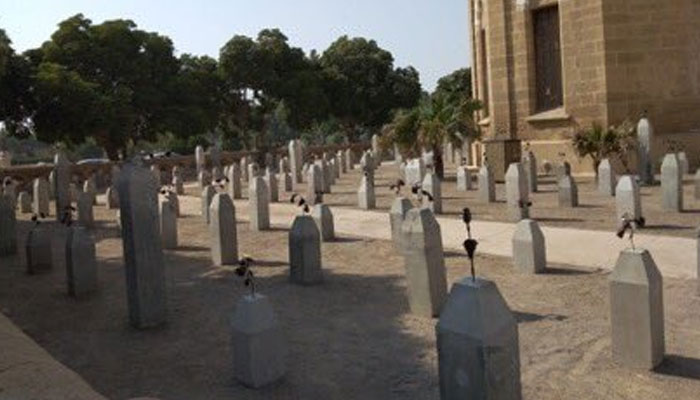KB19 organisers take a flak for distancing themselves from Adeela Suleman’s artwork
The second Karachi Biennale 2019 turned controversial after its management through a Facebook status distanced itself from artist Adeela Suleman’s artwork ‘Killing Fields of Karachi’ displayed at the Frere Hall as part of the Karachi Biennale 2019, which was forcibly shutdown on Sunday.
Suleman, who is an associate professor and head of the Fine Arts Department at the Indus Valley School of Art and Architecture, had featured 444 tombstones, crowned with wilted metal flowers at the Frere Hall. Each pillar, according to her, represented a victim of the infamous former SSP Rao Anwar – who is alleged to have been directly or indirectly involved in the killings of 444 persons in suspected police encounters.
The installation was supplemented by a documentary on the murder of Naqeebullah Mehsud, who was killed in a fake police encounter allegedly on Anwar’s orders. The Karachi Biennale remained silent on the issue until Monday evening, after which through a Facebook status they said they were against censorship of art and believed that expression was very subjective to the viewers’ interpretation of the artwork.
“With regards to the exhibit in question, we feel that despite the artist’s perspective, it is not compatible with the ethos of #KB19 whose theme is ‘Ecology and the Environment’, and feel that politicising the platform will go against our efforts to bring art into the public and drawing artists from the fringe to the mainstream cultural discourse.”
They said that the city government had been part of the entire process and the theme this year did not warrant a political statement on an unrelated issue, as all artists had agreed to focus on ecology and environment within the framework of cultural sensitivities.
The Biennale team hoped that the artists community would understand that their platform, as had been illustrated through their projects, was purely to promote art to build a large public audience and any public event had to work within certain agreed boundaries. “To ensure a sustainable future of Karachi Biennale, it is imperative that we focus on its mandate to connect art, the city and its people.”
This statement of the Biennale team met with criticism not only from Suleman, but from the artist community and civil society, which protested on Monday at the Frere Hall against elements involved in vandalising Suleman’s work.
Speaking to The News, Suleman asked if the theme of environment and ecology was not political. She said even bringing art to public space was a political act. “What is the capability of their [The Biennale] organising team if they aren’t aware what an artist is doing?” she asked.
“Is that what they are saying that they are so incapable that were not aware what their artist is doing?” Suleman has been working on this project for the past seven months at her personal studio for the Biennale.
On a question regarding the theme, she said that if art could display a polluted sea, polluted wind, then why it could not show a “polluted mind”. “I was talking about the ecology of violence through my work.” The curator of The Karachi Biennale, Muhammad Zeeshan, had complete knowledge of what she was doing. The work was displayed on Friday and the Biennale’s jury visited her exhibition.
It is the power of art which she believes has created waves on the issue. “It was a peaceful way of commenting on an event. A story [of killings] was re-narrated,” she said. Classic dancer and rights activist Sheema Kirmani, who was also there at the protest, believes that art is always political.
Talking to The News, she said that artistic expression was a political statement about society. “When we see violence and killings around us, we will obviously portray and bring it out in our artwork,” she said and added that the Biennale team should have informed them in advance if they didn’t want that work to be displayed.
She knows many artists who were informed personally by the team Biennale if they had any reservation over their artwork. “Once they have accepted an artist’s work, then they must stand by their work. It is their obligation.” she said and added that she was also part of the Biennale and was inquired about her work. “I had to give them a written statement about the work I was presenting,” she said.
Advocate and rights activist Jibran Nasir in a tweet said that one would have understood the Karachi Biennale’s compulsion had they not said anything, “but issuing a statement distancing itself from its artists is standing with the oppressor and supporting oppression”.
A professor of sociology at the Lahore Institute of Management Sciences (LUMS) Nida Kirmani, also took to Twitter and remarked that the Biennale organisers had put up an extremely disappointing and cowardly statement on their Facebook page. “The Karachi Biennale Foundation has chosen to throw one of their artists under the bus in order to protect their own interests rather than standing on the right side of history and defending freedom of expression,” she said.
Two internationally recognised artists, Rashid Rana and Imran Qureshi, are also displaying their artwork at the Frere Hall under the Karachi Biennale. The Karachi team of Biennale, according to the sources, has cancelled a visit of all their international delegations to the Frere Hall after the incident.
The protest
Activists, citizens, students and art lovers gathered at the Frere Hall on Monday to protest against the demolition of Suleman’s work, and also tried to restore her artwork.
The lower hall of the building, where part of the exhibit was displayed, was sealed by the park’s management. A few of the gravestones which were displayed out in the park had been dismantled. “My students on Monday morning resurrected the pillars [tombstones], then later someone again dismantled and broke them into pieces,” she said and added that when at around 5pm they all re-gathered at the hall, they tried to pick the broken pieces and erect them in a wobbly position.
The Karachi Biennale Trust (KBT) conspicuously avoided media. CEO Karachi Biennale Trust (KBT) Niilofur Farrukh was repeatedly contacted for comment, but she didn’t respond.
Speaking at a press conference at the Karachi Press Club before the Biennale, she had shared how there were five prizes in the KBT for artists. Individuals, foundations and companies are behind these five KBT prizes that recognise outstanding work and achievements. One will be KBT H M Habib Lifetime Achievement Award for someone who has served visual art for 40 years. “They are chosen from all provinces,” she had said.
A project-based emerging artist award for the newcomers, Langdon-Malik Foundation Performance Art award, the KBT Shahneela and Farhan Faruqui Popular Choice Art Prize and the KBT Mahvesh and Jahangir Siddiqui Foundation Juried Art prize are also part of the Biennale from which Suleman has surely been excluded.
-
 Defying Age At Milano Cortina Games: Canadian Skater Stellato-Dudeke Aims For Gold At 42
Defying Age At Milano Cortina Games: Canadian Skater Stellato-Dudeke Aims For Gold At 42 -
 Study Finds Screen Time Does Not Harm Teenagers’ Mental Health
Study Finds Screen Time Does Not Harm Teenagers’ Mental Health -
 'Dunesday': What Robert Downey Jr. And Timothee Chalamet Really Think
'Dunesday': What Robert Downey Jr. And Timothee Chalamet Really Think -
 UK Regulator Reaffirms Ongoing Investigation Into X Deepfake Probe
UK Regulator Reaffirms Ongoing Investigation Into X Deepfake Probe -
 'Marty Supreme' Featured Secret Robert Pattinson Cameo?
'Marty Supreme' Featured Secret Robert Pattinson Cameo? -
 ‘Operation Arctic Endurance’: Which NATO Nations Are Sending Troops To Greenland?
‘Operation Arctic Endurance’: Which NATO Nations Are Sending Troops To Greenland? -
 Kate Middleton ‘disgusted’ As Andrew Points Finger At Her Over Royal Downfall
Kate Middleton ‘disgusted’ As Andrew Points Finger At Her Over Royal Downfall -
 YouTube Adds New Parental Controls For Teens, Limits Shorts Scrolling
YouTube Adds New Parental Controls For Teens, Limits Shorts Scrolling -
 Sarah Ferguson Takes Big Decision As Royal Lodge Eviction Looms
Sarah Ferguson Takes Big Decision As Royal Lodge Eviction Looms -
 Bruno Mars Leaves Taylor Swift Behind With Shocking Move
Bruno Mars Leaves Taylor Swift Behind With Shocking Move -
 Trump Administration Imposes 25% Tariff On Imports Of Some AI Chips
Trump Administration Imposes 25% Tariff On Imports Of Some AI Chips -
 Chinese Smartphone Makers Adjust Prices As Costs Go Up
Chinese Smartphone Makers Adjust Prices As Costs Go Up -
 Wikipedia Owner Signs AI Content Training Deals With Microsoft, Meta
Wikipedia Owner Signs AI Content Training Deals With Microsoft, Meta -
 Meghan Markle’s Real Feelings Revealed Amid UK Return Rumours
Meghan Markle’s Real Feelings Revealed Amid UK Return Rumours -
 Reese Witherspoon Issues Urgent Warning After Scammers Using Her Identity
Reese Witherspoon Issues Urgent Warning After Scammers Using Her Identity -
 XAI Restricts Grok Image Editing After Backlash From California And Europe
XAI Restricts Grok Image Editing After Backlash From California And Europe




